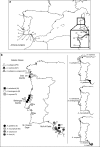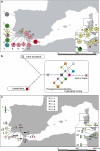Introgression in peripheral populations and colonization shape the genetic structure of the coastal shrub Armeria pungens
- PMID: 20424642
- PMCID: PMC3183879
- DOI: 10.1038/hdy.2010.46
Introgression in peripheral populations and colonization shape the genetic structure of the coastal shrub Armeria pungens
Abstract
The coastal shrub Armeria pungens has a disjunct Atlantic-Mediterranean distribution. The historic range expansion underlying this distribution was investigated using the nuclear internal transcribed spacer region, three plastid regions (namely trnL-F, trnS-fM and matK) and morphometric data. A highly diverse ancestral lineage was identified in southwest Portugal. More recently, two areas have been colonized: (1) Corsica and Sardinia, where disjunct Mediterranean populations have been established as a result of the long-distance dispersal of Portuguese genotypes, and (2) the southern part of the Atlantic range, Gulf of Cadiz, where a distinct lineage showing no genetic differentiation among populations occurs. Genetic consequences of colonization seem to have been more severe in the Gulf of Cadiz than in Corsica-Sardinia. Although significant genetic divergence is associated with low plastid diversity in the Gulf of Cadiz, in Corsica-Sardinia, the loss of plastid haplotypes was not accompanied by divergence from disjunct Portuguese source populations. In addition, in its northernmost and southernmost populations, A. pungens exhibited evidence for ancient or ongoing introgression from sympatric congeners. Introgression might have created novel genotypes able to expand beyond the latitudinal margins of the species or, alternatively, these genotypes may be the result of surfing of alleles from other species in demographic equilibrium into peripheral populations of A. pungens. Our results highlight the evolutionary significance of genetic drift following the colonization of new areas and the key role of introgression in range expansion.
Figures




References
-
- Abbott RJ. Plant invasions, interspecific hybridization and the evolution of new plant taxa. Trends Ecol Evol. 1992;7:401–405. - PubMed
-
- Abbott CL, Double MC. Genetic structure, conservation genetics and evidence of speciation by range expansion in shy and white-capped albatrosses. Mol Ecol. 2003;12:2953–2962. - PubMed
-
- Albert V, Jonsson B, Bernatchez L. Natural hybrids in Atlantic eels (Anguilla anguilla, Arostrata): evidence for successful reproduction and fluctuating abundance in space and time. Mol Ecol. 2006;15:1903–1916. - PubMed
-
- Alsos I, Bronken Eidesen P, Ehrich D, Skrede I, Westergaard K, Jacobsen GH, et al. Frequent long-distance plant colonization in the changing Arctic. Science. 2007;316:1606–1609. - PubMed
Publication types
MeSH terms
LinkOut - more resources
Full Text Sources
Molecular Biology Databases
Miscellaneous

